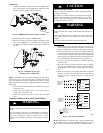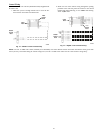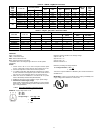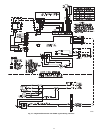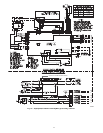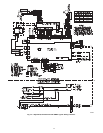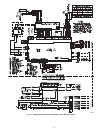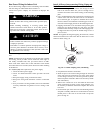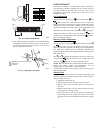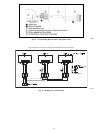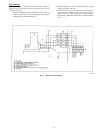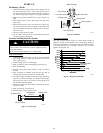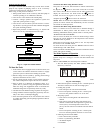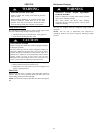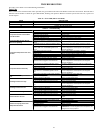
22
SERVICE
!
WARNING
ELECTRICAL SHOCK HAZARD
Failure to follow this warning could result in personal
injury or death.
Before installing, modifying, or servicing system, main
electrical disconnect switch must be in the OFF
position. There may be more than 1 disconnect switch.
Lock out and tag switch with a suitable warning label.
Pump--down Procedure
The system may be pumped down in order to make repairs on the
low side without losing complete refrigerant charge.
1. Attach pressure gage to suction service valve gage port.
2. Front--seat the mixed phase line valve.
CAUTION
!
UNIT DAMAGE HAZARD
Failure to follow this caution may result in equipment damage
or improper operation.
The unit coils hold only the factory--designated amount of
refrigerant. Additional refrigerant may cause units to relieve
pressure through the compressor internal pressure relief valve
(indicated by a sudden rise of suction pressure) before suction
pressure reaches 20 psig. If this occurs, shut off unit
immediately then front--seat the suction valve and remove and
recover excess refrigerant following accepted practices.
3. Start unit and run until suction pressure reaches 5 psig.
4. Shut unit off and front--seat suction valve.
5. Depressurize low side of unit and recover refrigerant fol-
lowing accepted practices.
Filter Drier
Whenever the filter drier is exposed to the atmosphere it must be
replaced. Only use factory specified liquid--line filter driers with
rated working pressures less than 600 psig.
NOTE: Do not install a suction--line filter drier in the mixed phase
line.
Refrigerant Charging
!
WARNING
PERSONAL INJURY AND/OR EQUIPMENT
DAMAGE HAZARD
Failure to follow this warning could result in personal
injury and/or equipment damage.
Wear safety glasses and gloves when handling
refrigerant. Do not overcharge system -- this can cause
compressor flooding.
All units are shipped with the refrigerant charge listed on
nameplate.
NOTE: Do not vent or depressurize unit refrigerant to
atmosphere. Remove and recover refrigerant following accepted
practices.



